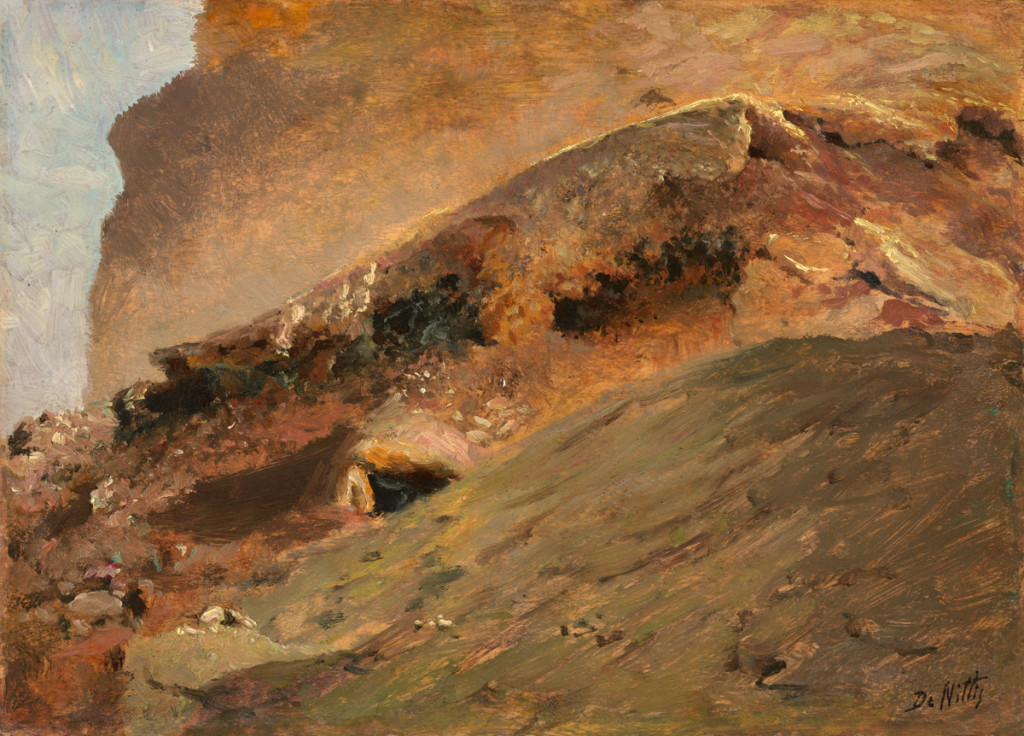Giuseppe de Nittis (Barletta 1846 - 1884 St.-Germain-en-Laye)
Streams of Lava, Mount Vesuvius, 1872
Oil on panel, 13 x 18 cm
Signed lower right De Nittis
Bearing the estate stamp on the verso Atelier de Nittis;
Labels of the Sommaruga collection and the Angiolini collection
Provenance:
Angelo Sommaruga, Paris
Alvaro Angiolini, Livorno
Private collection, Bari
The studies Giuseppe de Nittis executed of Vesuvius between 1871 and 1872 occupy an important position in his oeuvre. He was already an established painter when he set off from Paris on a brief visit to his native Italy in the autumn of 1870. The outbreak of the Franco-Prussian War in the same year prolonged his visit and it was almost three years before he could return to Paris. He lodged for a time in Naples before moving to Resina, a small village perched on the slopes of Vesuvius where he was to live until 1873. Here, far from the city, he could draw inspiration from nature and return to landscape painting, the preferred genre of his early career. The fascination of Vesuvius - then entering a period of renewed activity - quickly captured his imagination and the new focus of his work became the volcano and the natural phenomena that accompanied the eruptions.[1]
De Nittis displays his skilful handling of unconventional perspectival effects in this oil study. The very close-up view of solidified lava streams almost entirely fills the surface of the image. By compressing the motif into a remarkably small format he achieves the urgency of a photograph spontaneously taken and very close to the object. The immediacy of the image is compelling. De Nittis was very interested in, and was to experiment with photographic techniques. In his depiction of the solidified lava he focuses exclusively on textural values. If it were not for the narrow band of sky at the upper left of the image the study could be interpreted as an entirely non-objective composition. Shades of brown, red and black applied in rapid, delicately articulated brushstrokes are used to model the different varieties of rock and stone. Areas of transparent brushwork in the upper part of the image serve as a compositional device to allow the yellowish-brown tone of the panel and the grain of the wood to shimmer through.
De Nittis recorded in his diary his impressions of volcanic activity and experiences of plein-air sketching. The daily ascent and descent on horseback took no less than six hours. As a daily observer of the volcano he was able to experience at first hand the major eruption of 26 April 1872, an event that was to leave a lasting impression on him. Over a period of many months he produced a large group of small-format plein-air oil studies documenting the bellezza selvaggia[2] [wild beauty] of nature. Whereas previously it had been common practice among artists like Volaire, Catel, Fabris, Hackert and Wright of Derby to produce theatrical images of the eruption of Vesuvius as spectacular mementos for Grand Tour travellers, de Nittis concentrated on the rich diversity of changes in weather and light conditions. His oil sketches reveal a fascination for light and colour.
[1] Emanuela Angiuli and Fernando Mazzocca (eds.), De Nittis, exhib. cat., Padua, Palazzo Zabarella, Venice 2013, pp.100-3 and 212-4. [2] Giuseppe de Nittis, Taccuino 1870-1884, with a Preface by E. Cecchi, Bari 1964, p. 75: bellezza selvaggia.

